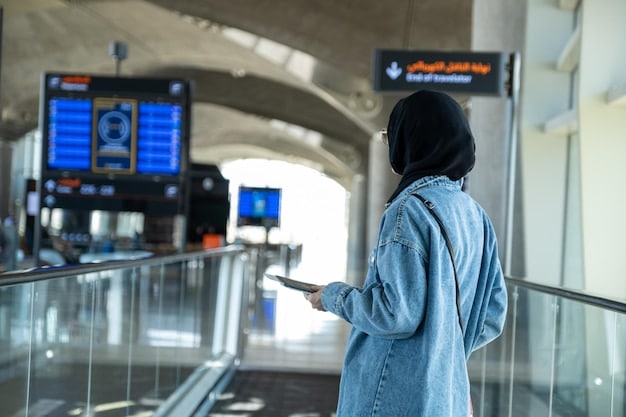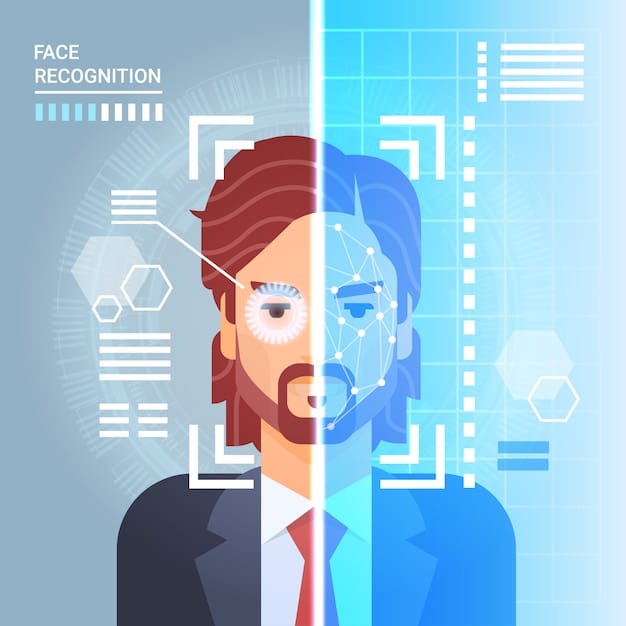Facial Recognition at US Airports: Privacy and New Regulations

The implementation of facial recognition technology in US airports, while aiming to enhance security and efficiency, raises significant privacy concerns that necessitate robust regulatory frameworks to balance security needs with individual civil liberties.
The integration of facial recognition technology in US airports: privacy concerns and new regulations continues to evolve rapidly, transforming how travelers navigate security checkpoints. This sophisticated technology promises enhanced efficiency and bolstered security, but its widespread deployment has ignited a crucial debate regarding privacy rights and the imperative for comprehensive regulatory oversight.
The Rise of Facial Recognition in Airport Security
The adoption of facial recognition technology in US airports has been a gradual yet impactful development, initially piloted in specific scenarios and now expanding to become a more integral part of the travel experience. This technology, powered by advanced algorithms, aims to streamline the identification process, verifying traveler identities against databases to facilitate quicker boarding, immigration, and security checks. The Department of Homeland Security (DHS) and Customs and Border Protection (CBP) have championed its deployment, citing improvements in operational efficiency and enhanced security measures as primary drivers. Early implementations focused on international travelers, particularly non-US citizens, to verify their exit from the country, and later expanded to include US citizens on a voluntary basis for specific programs.
The initial rollout involved significant investment in infrastructure, including specialized cameras and data processing systems capable of handling large volumes of biometric data. Airlines, too, have embraced the technology, often partnering with government agencies to integrate facial recognition into their boarding processes. This collaboration seeks to create a seamless journey from check-in to boarding, reducing wait times and improving the overall passenger experience. The promise of touchless processing, especially amplified by global health concerns, has further accelerated its adoption, presenting an attractive alternative to traditional document checks. However, this convenience also brings with it a complex array of questions surrounding data handling, storage, and the potential for misuse.
Key Drivers for Adoption
Several factors underpin the push for facial recognition in US airports:
- Enhanced Security: The ability to quickly and accurately identify individuals helps to prevent imposters and increase the security posture against potential threats.
- Operational Efficiency: Automated identity verification can significantly reduce processing times at various checkpoints, leading to shorter queues and smoother passenger flow.
- Counter-terrorism Efforts: By verifying identities against watchlists, the technology aids in identifying individuals who may pose a security risk before they board a flight or enter the country.
The technology works by capturing a live image of a traveler’s face and comparing it to a stored image, often from a passport, visa, or immigration document. This comparison is performed by algorithms that analyze unique facial features, creating a biometric template. If the templates match within an acceptable threshold, the traveler is cleared to proceed. This process, while seemingly straightforward, involves intricate data flows and raises fundamental questions about how an individual’s most personal information is managed and protected in a governmental and commercial context.
The proliferation of facial recognition systems across various airport touchpoints underscores a broader trend towards biometric identification in critical infrastructure. While the benefits in terms of security and efficiency are often highlighted, the ethical implications and the potential for privacy infringements remain central to public and policy discussions. Understanding these underlying drivers is crucial to appreciating the evolving landscape of airport security and the regulatory challenges it presents. The shift from manual checks to automated biometric verification represents a paradigm change, necessitating a thorough re-evaluation of existing privacy frameworks to ensure they are fit for purpose in the digital age.
Understanding the Privacy Concerns Associated with Biometric Data
The deployment of facial recognition technology in US airports, while offering undeniable benefits in security and efficiency, inevitably brings to the forefront profound privacy concerns, particularly regarding the handling of sensitive biometric data. Unlike traditional forms of identification, biometric data—such as facial scans—are unique to an individual and cannot be changed if compromised. This permanence raises significant anxieties about data breaches, identity theft, and the potential for unauthorized surveillance. The collection, storage, and sharing of such immutable personal information demand an exceptionally high level of protection and transparency.
Data Collection and Storage Risks
The core of the privacy debate revolves around how facial images are collected and stored. When a traveler passes through a facial recognition gate, their image is captured and, in many cases, compared against a vast database of existing photos, which could include passport photos, visa photos, or even images from other government databases. This centralized storage of biometric data creates a lucrative target for cybercriminals. A single successful breach could expose millions of individuals to perpetual identity risks, given that a compromised facial scan cannot simply be replaced like a lost password. Concerns also extend to the retention periods of this data. How long are these images stored? What are the protocols for their deletion? The lack of clear, consistent policies across all agencies and airlines often exacerbates these worries, leaving individuals feeling vulnerable to indefinite data retention and potential future misuse.
Beyond security vulnerabilities, there are also ethical considerations about the scope of data collection. Is it truly necessary to collect and store biometric data from all travelers, or could less invasive methods suffice for most? For US citizens, participation in facial recognition programs is generally voluntary, but the alternatives offered might be less convenient, implicitly coercing individuals towards opting in. For international travelers, the voluntary nature is often less clear or non-existent, raising questions of consent and individual autonomy in transit environments.
Mission Creep and Surveillance Fears
Another critical concern is “mission creep,” where technology initially deployed for one purpose gradually expands its scope to encompass other, potentially more intrusive applications. Facial recognition systems in airports are primarily intended for identity verification and security. However, with the increasing sophistication of these systems, there is a legitimate fear that they could be repurposed for broader surveillance activities, tracking individuals’ movements outside of the airport, or being linked to other governmental or even commercial databases without explicit consent. This possibility transforms a targeted security measure into a tool for pervasive monitoring, eroding fundamental civil liberties and the expectation of privacy in public spaces.
The lack of robust independent oversight further compounds these fears. While government agencies operate under certain legal frameworks, the rapid pace of technological development often outstrips legislative and regulatory adjustments. This creates a regulatory vacuum where the boundaries of data collection and usage remain ambiguous, making it difficult for the public to understand their rights or seek redress if their data is misused. Advocates for privacy emphasize the need for clear guidelines, independent auditing, and transparent reporting mechanisms to prevent the expansion of surveillance capabilities beyond their original, stated intent. Without these safeguards, the line between security and surveillance becomes dangerously blurred, threatening the democratic principles of a free society.
Existing Regulations and Their Limitations
The legal and regulatory landscape surrounding facial recognition technology in US airports is a complex patchwork, evolving as quickly as the technology itself. While several policies aim to address privacy, their fragmented nature and inherent limitations often leave significant gaps in comprehensive protection. Current regulations primarily stem from various federal agencies and a mix of state and local laws, rather than a single, overarching federal framework specifically designed for biometric data in this context. This creates inconsistencies and complicates efforts to ensure uniform privacy safeguards across all airport operations.
The Transportation Security Administration (TSA) and Customs and Border Protection (CBP) are the primary federal entities implementing facial recognition at airports. Their operations are generally governed by statutes such as the Intelligence Reform and Terrorism Prevention Act of 2004, which mandates biometric data collection for certain travelers, and the E-Government Act of 2002, requiring privacy impact assessments (PIAs) for new information technology systems. While PIAs are conducted, critics argue they are often insufficient in addressing the full scope of privacy risks or are implemented after the fact, rather than as a proactive measure influencing system design.
Federal Agencies’ Policies
CBP’s use of facial recognition, particularly for international travelers, operates under its Congressional mandate to verify identities for entry and exit. For US citizens, the program is generally presented as voluntary, allowing them to opt-out and undergo traditional document checks. However, this “opt-out” mechanism has been a point of contention, with some privacy advocates arguing that the process of opting out can be inconvenient or create unnecessary delays, effectively pressuring travelers into participation. Moreover, the data retention policies vary. While CBP states it deletes photos of US citizens within 12 hours unless a watch-list match is made, the policies for non-US citizens or data shared with third parties by airlines can be less clear or involve longer retention periods.
The TSA’s pilots of facial recognition for domestic travelers face even greater scrutiny regarding voluntariness and necessity. Unlike international travel where border security is a clear federal mandate, domestic travel traditionally involves fewer biometric checks. The legal basis for extensive domestic biometric collection, particularly when not tied to a specific threat, is often questioned. Furthermore, the lack of explicit federal legislation specifically defining permissible uses, storage, and sharing of biometric data for security purposes at airports creates legal ambiguities that permit agencies substantial discretion.
State and Local Regulations
Adding another layer of complexity are state and local initiatives. Some states have passed their own legislation restricting the use of facial recognition by government agencies or requiring consent, but these laws generally do not apply to federal operations at airports, creating a jurisdictional grey area. For instance, states like Illinois have the Biometric Information Privacy Act (BIPA), which requires consent for biometric data collection by private entities and provides a private right of action for violations. While BIPA primarily targets private companies, its existence highlights a growing recognition at the state level of the unique sensitivities surrounding biometric data, a recognition often less explicitly mirrored in federal airport policies.
The limitations of current regulations are manifold:
- Lack of Comprehensive Federal Law: There is no single, overarching federal law specifically dedicated to governing the collection, use, retention, and dissemination of biometric data by government agencies or private entities in public spaces like airports.
- Inconsistent Opt-Out Processes: While “voluntary” for US citizens, the practicalities of opting out can be burdensome, potentially undermining true consent.
- Ambiguous Data Sharing: The extent to which biometric data is shared between different government agencies, airlines, and even international partners often lacks transparency, raising concerns about potential onward sharing and secondary uses.
- Limited Individual Redress: Mechanisms for individuals to access, correct, or challenge the use of their biometric data, or seek redress for privacy violations, are often unclear or inadequate.
In essence, the current regulatory framework is a reactive system, largely attempting to fit new technologies into old legal structures. This creates a precarious balance between security innovation and privacy protection, underscoring the urgent need for a more coherent, proactive, and rights-based regulatory approach in the era of pervasive biometric identification.
The Debate: Security vs. Privacy
The extensive deployment of facial recognition technology in US airports has ignited a foundational debate that pits national security imperatives against individual privacy rights. This tension is not new in public policy, but the unique nature of biometric data—its immutability and the potential for widespread, passive collection—lends an unprecedented urgency to the discussion. Proponents of the technology primarily emphasize its capacity to enhance security and streamline travel, while privacy advocates warn of a slippery slope towards ubiquitous surveillance and the erosion of fundamental civil liberties.
From a security perspective, facial recognition is touted as a critical tool in an increasingly complex global threat landscape. Arguments often center on its ability to:
- Deter Terrorism: By quickly identifying individuals against terrorist watchlists and criminal databases, the technology can act as a preventative measure, stopping potential threats before they materialize.
- Combat Smuggling and Illegal Immigration: Accurate identity verification at border crossings and within airports can help to identify individuals attempting to enter or exit the country illegally, or those involved in illicit activities.
- Improve Law Enforcement Capabilities: In the event of an incident, facial recognition could aid in retrospective investigations, helping to identify suspects or track their movements.
These arguments often highlight the speed and accuracy of the technology compared to manual checks, suggesting that automating identity verification frees up human resources for more critical tasks and reduces vulnerabilities. The desire for a safer and more efficient travel system is a powerful motivator for both government agencies and the public. In a post-9/11 world, robust security measures at transportation hubs are often seen as a non-negotiable imperative.

However, the privacy counter-argument is equally compelling, focusing on the potential for abuse and the long-term societal consequences of widespread biometric surveillance. Key concerns include:
Surveillance Society Risks
The core fear is the gradual normalization of pervasive surveillance. If every movement through public spaces like airports is tracked and recorded using biometrics, it could lead to a chilling effect on legitimate activities and foster a sense of being constantly observed. This diminishes the expectation of privacy that many consider a cornerstone of democratic societies. The potential for data aggregation—linking airport facial scans with other databases (e.g., social media, public records, commercial transactions)—raises the specter of comprehensive real-time profiles of individuals, which could be used for purposes far beyond security, including predictive policing or even social scoring, as seen in some authoritarian regimes.
Moreover, errors in facial recognition systems, particularly concerning issues of bias against certain demographics, can lead to false positives, resulting in innocent individuals being flagged, interrogated, or even detained. The consequences of such errors, given the high stakes of airport security, can be severe and disproportionately affect minority groups. The lack of transparent redress mechanisms for individuals who are misidentified further exacerbates these concerns.
Erosion of Public Trust
The debate also touches upon public trust. If citizens perceive that their privacy is being eroded without adequate safeguards or transparent oversight, it can lead to a breakdown in trust between the public and government institutions. This erosion of trust can, in turn, make populations less willing to cooperate with security measures, paradoxically undermining the very security objectives the technology aims to achieve. The principle that fundamental rights should not be sacrificed in the name of security, unless absolutely necessary and with robust oversight, is central to the privacy advocacy position.
Ultimately, balancing security needs with privacy rights requires a nuanced approach. It involves acknowledging the genuine benefits of technology while also proactively addressing the profound risks. The conversation is not about whether to use technology, but how to use it responsibly, ethically, and within a framework that respects and protects individual liberties in an increasingly data-driven world. The current debate signifies a critical juncture in determining the future balance between convenience, safety, and personal freedom.
New Regulations and Legislative Proposals
Recognizing the growing privacy concerns and the limitations of existing frameworks, there has been a significant push in recent years for clearer, stronger regulations governing facial recognition technology. Both federal and state legislative bodies, as well as advocacy groups, are actively proposing new rules and best practices to ensure that the deployment of this technology in US airports, and indeed wider society, is conducted ethically and with robust privacy safeguards.
At the federal level, several legislative proposals have emerged, though none have yet been enacted into comprehensive law. These proposals typically aim to establish a national framework for biometric data privacy, moving beyond the fragmented agency-specific policies. Key elements of these proposed legislations often include:
- Requiring Explicit Consent: Mandating that individuals provide clear, informed, and explicit consent before their biometric data is collected, particularly for US citizens. This would strengthen the “voluntary” aspect beyond a simple opt-out.
- Data Minimization: Limiting the amount of biometric data collected to only what is strictly necessary for the stated purpose, and specifying strict retention periods.
- Prohibition on Certain Uses: Outlawing specific applications, such as linking airport biometric data with commercial databases or using it for generalized surveillance without a warrant.
- Independent Oversight and Auditing: Establishing independent bodies to oversee the implementation of facial recognition systems, conduct regular audits for accuracy, bias, and compliance, and provide transparent reporting to the public.
One notable example is the “Facial Recognition and Biometric Technology Moratorium Act of 2021,” a federal bill that sought to place a moratorium on the use of facial recognition technology by federal law enforcement agencies until Congress could establish a framework of robust privacy protections. While this bill did not pass, it signaled a strong push for a more cautious approach and a recognition of the need for legislative action rather than relying solely on agency policies. Many proposals also emphasize enhancing transparency, requiring public notification of facial recognition deployments and clearer pathways for individuals to understand how their data is being used and to seek redress.

Beyond federal legislative efforts, there is also a growing movement for standardized technical specifications and ethical guidelines. Organizations like the National Institute of Standards and Technology (NIST) play a crucial role in testing the accuracy and bias of facial recognition algorithms. Their research often highlights performance disparities across demographic groups, underscoring the urgent need for improvements in algorithmic fairness before widespread deployment. New regulations are increasingly expected to incorporate these technical standards, requiring systems to meet certain accuracy thresholds and undergo regular bias testing to ensure equitable treatment for all travelers.
International Influence
The regulatory landscape is also influenced by international developments. The European Union’s General Data Protection Regulation (GDPR), for instance, has set a high global standard for data privacy, including strict rules around biometric data. While GDPR does not directly apply to US airport operations, its principles often serve as a benchmark or a source of inspiration for US lawmakers seeking to craft robust privacy legislation. The increasing interconnectedness of global travel means that international privacy norms and legislative trends can significantly impact how technology is deployed and regulated in the US.
In summary, the legislative response to facial recognition in US airports is shifting towards more comprehensive and rights-focused approaches. While the path to enacted federal legislation is often slow and fraught with political complexities, the ongoing proposals and the increasing public demand for clearer rules indicate a clear trend: the future of facial recognition in airports will likely involve a more regulated, transparent, and accountability-driven environment designed to better protect individual privacy while still leveraging technology for legitimate security goals. The debate is no longer solely about whether to use the technology, but how to ensure its use is responsible and respects fundamental human rights.
The Future Landscape: Balancing Innovation and Rights
The trajectory of facial recognition technology in US airports suggests a future where innovation and individual rights must find a delicate and pragmatic balance. The continued advancement of AI and biometric capabilities guarantees that these systems will become ever more sophisticated, accurate, and integrated into the travel ecosystem. However, this progress must be met with equally robust and forward-thinking regulatory frameworks that anticipate challenges and protect civil liberties. The goal is not to halt technological progress, but to guide its deployment in a manner that serves humanity rather than compromises it.
One key aspect of this future landscape will be the increasing emphasis on transparency and accountability. As more travelers encounter facial recognition systems, there will be a growing demand for clear information about how their data is used, who has access to it, and for how long it is retained. This could involve more prominent signage, simplified privacy notices, and easily accessible digital portals where individuals can review or request deletion of their biometric data. Airlines and government agencies will likely face greater pressure to publish detailed reports on system performance, including error rates and bias assessments, to foster public trust.
Emerging Technologies and AI Ethics
The development of even more advanced biometric technologies, alongside general AI advancements, poses new questions for regulation. For instance, gait analysis, behavioral biometrics, or even predictive analytics based on aggregated data could become part of future airport security screening. Regulations will need to be agile enough to address these emerging capabilities, ensuring that ethical considerations are embedded in the design and deployment phases, not merely as an afterthought. This includes addressing the “black box” problem of AI, where algorithms operate without clear human interpretability, making it difficult to understand how decisions are made or why errors occur. Future regulations might mandate explainable AI (XAI) principles to ensure greater transparency in algorithmic decision-making.
Furthermore, the concept of “privacy by design” is gaining traction. This approach advocates for embedding privacy protections into the very architecture of technology and operational processes from the outset, rather than adding them as a reactive fix. For airport facial recognition, this means designing systems that:
- Minimize data collection.
- Encrypt data effectively.
- Provide clear opt-out mechanisms that are as convenient as opting in.
- Implement robust access controls and audit trails.
Such proactive measures can significantly mitigate privacy risks and build a stronger foundation of trust between users and the technology.
The role of international cooperation will also be increasingly vital. As travelers move across borders, the standards for biometric data collection and sharing need to be harmonized to some extent. Collaborative efforts between nations can help establish common principles for data protection and cross-border data transfer agreements, ensuring that an individual’s privacy rights are protected regardless of where they travel. This is particularly relevant as many airlines and international border control agencies cooperate on global entry and exit programs that leverage biometric data.
Continuous Public Discourse
Finally, the future landscape will undoubtedly involve continuous public discourse and engagement. Privacy is not a static concept; its interpretation evolves with technological capabilities and societal values. Maintaining an open dialogue among policymakers, technology developers, privacy advocates, and the public will be crucial for adapting regulations and ensuring that the deployment of facial recognition technology aligns with the democratic values of freedom and individual autonomy. The balance between security and privacy in airports is a dynamic equilibrium, and its future will be shaped by how effectively these diverse stakeholders can collaborate to achieve both security and protection of rights.
How Travelers Can Protect Their Privacy
In an era where facial recognition technology is becoming increasingly prevalent in US airports, travelers understandably seek ways to protect their privacy while navigating security and boarding processes. While federal agencies often cite the voluntary nature of facial recognition for US citizens, understanding the nuances of these programs and knowing your options is essential. Empowerment comes from informed choices, and there are several steps individuals can take to safeguard their biometric data even amidst evolving airport technologies.
The primary and most direct way for US citizens to protect their privacy related to airport facial recognition is to understand and exercise their right to opt out. Customs and Border Protection (CBP) and the Transportation Security Administration (TSA) maintain that participation in biometric screening for US citizens is voluntary.
- Opting Out: When encountering a facial recognition camera at a boarding gate or security checkpoint, you have the right to decline participation. Inform the airline or TSA agent that you wish to opt out of the facial recognition scan. In most cases, you will then be directed to a manual identity verification process, where an agent will visually check your passport or ID against your face. While this may potentially add a few extra moments to your processing time, it is your fundamental right.
- Confirming Opt-Out Procedures: It’s advisable to be aware of how different airlines or airports manage the opt-out process, as it can vary slightly. Some may have dedicated lines, while others simply switch to a manual check at the same station. Your proactive communication is key.
Before traveling, it’s also prudent to stay informed about the specific policies of the airports you’ll be using and the airlines you’ll be flying. Many airports and airlines provide information on their websites regarding their use of facial recognition technology. Reviewing these policies can give you a clearer picture of what to expect and which systems are in place. This includes understanding what data is collected, how long it is stored, and whether it is shared with third parties.
Being Mindful of Data Sharing
Beyond the direct airport biometric scans, travelers should also be mindful of broader data privacy practices. Apps and services related to travel can sometimes request extensive permissions or collect data that could indirectly be linked to your identity. Always review privacy policies for travel apps and consider limiting permissions or using alternative, privacy-focused services where possible. Public Wi-Fi networks in airports can also be vulnerable, making it important to use a Virtual Private Network (VPN) or limit sensitive activities on these networks.
Even with the advancements in facial recognition, being aware of your surroundings and the technologies in use can help empower your decisions:
- Be Observant: Notice where facial recognition cameras are placed and if you are being asked to stand in a specific way for a scan.
- Ask Questions: Don’t hesitate to ask airport or airline staff about their processes if something is unclear or makes you uncomfortable. Understanding the system is the first step toward exercising your rights effectively.
- Advocate for Stronger Protections: Beyond individual actions, contributing to the broader conversation about privacy and advocating for stronger legislative protections is also crucial. Supporting organizations that champion digital rights and urging lawmakers to implement comprehensive biometric privacy laws can help shape a future where technology is deployed responsibly and ethically.
While the convenience of emerging technologies is often attractive, protecting personal privacy in an increasingly digitized travel environment requires diligence and informed action. By understanding your rights, exercising options like opting out, and staying informed about evolving policies, travelers can significantly enhance their control over their biometric data in US airports and beyond.
Ethical Considerations and Societal Impact
The widespread adoption of facial recognition technology in US airports extends beyond mere technical implementation and regulatory frameworks; it delves deeply into fundamental ethical considerations and has broad societal impacts. These concerns touch upon issues of fairness, equity, human dignity, and the very fabric of democratic societies. Ignoring these ethical dimensions would be to overlook a critical component of responsible technological deployment.
One of the most significant ethical concerns is the potential for bias and discrimination inherent in current facial recognition algorithms. Studies by organizations like the National Institute of Standards and Technology (NIST) have repeatedly shown that these algorithms often perform less accurately on certain demographic groups, particularly women, people of color, and individuals with non-binary gender expressions. This bias can lead to higher rates of false positives or false negatives for these groups, potentially resulting in disproportionate scrutiny, delayed processing, or even wrongful accusations in a high-stakes environment like an airport. Such discriminatory outcomes are not only unfair to individuals but also undermine the principle of equal treatment under the law.
Human Dignity and Autonomy
Another ethical dimension revolves around human dignity and personal autonomy. The notion of being constantly scanned and identified by machines, often without explicit and informed consent, can be unsettling. It can lead to a sense of dehumanization, where individuals are reduced to data points rather than being treated with respect as citizens. The loss of anonymity in public spaces chips away at the freedom to move and associate without constant surveillance, a freedom many consider essential for a thriving democratic society. When individuals feel their every movement could be tracked, it can foster self-censorship and a chilling effect on legitimate expression and assembly.
The societal impact extends to the normalization of surveillance. If people become accustomed to biometric scanning in airports, it could pave the way for its acceptance in other public spaces—shopping malls, schools, public transportation—without adequate debate or democratic oversight. This gradual expansion could lead to a “surveillance society” where privacy becomes a relic of the past, raising questions about the kind of society we are building for future generations. The balance between security and freedom is a foundational tenet of many nations, and the unchecked deployment of facial recognition risks tilting that balance irrevocably towards increased state control and reduced individual liberties.
Transparency and Accountability
Ethical deployment also demands transparency and accountability. Questions arise: Who is accountable if a system errs and causes harm? How can individuals challenge decisions made by algorithms? The opacity surrounding many facial recognition systems, coupled with a lack of clear human oversight, creates an accountability vacuum. Ethical frameworks would require clear lines of responsibility, robust avenues for redress, and independent auditing to ensure that the technology serves the public good and does not perpetuate or exacerbate existing societal inequalities. This includes ensuring that the developers and deployers of these systems are held responsible for their societal impact, beyond mere technical compliance.
Finally, there’s the ethical debate about “slippery slope” arguments: If this technology is allowed for convenience and security in airports, where do we draw the line? Establishing clear ethical boundaries and public consensus on where such technology is acceptable, and under what strict conditions, is crucial to prevent its creep into areas that compromise fundamental rights. These ethical considerations are not merely academic; they are vital for ensuring that technological progress genuinely enhances human well-being and freedom, rather than undermining it.
| Key Point | Brief Description |
|---|---|
| ✈️ Airport Use | Facial recognition streamlines security and boarding, increasing efficiency in US airports. |
| 🔒 Privacy Concerns | Risks include data breaches, mission creep, and potential for widespread surveillance without consent. |
| ⚖️ Regulatory Gaps | Current regulations are fragmented; a comprehensive federal law is needed for biometric data. |
| 💡 Traveler’s Rights | US citizens can typically opt out of facial scans by requesting a manual document check. |
Frequently Asked Questions
Facial recognition technology is primarily used in US airports to verify traveler identities against existing databases, streamlining security checks, immigration processes, and boarding procedures. It aims to enhance efficiency, reduce wait times, and bolster security by quickly confirming who a traveler is.
For US citizens, participation in facial recognition programs at US airports is currently voluntary. Travelers generally have the option to opt out and request a manual document check by an agent if they prefer not to use the biometric scanning system.
Key privacy concerns include the risk of data breaches, potential for “mission creep” (expanding surveillance beyond security), lack of clear data retention policies, and algorithmic bias that could disproportionately affect certain demographic groups during identification.
New regulatory proposals are pushing for more comprehensive federal laws, explicit consent requirements, data minimization principles, and independent oversight of facial recognition systems. They aim to balance security needs with individual privacy rights more effectively.
Travelers can protect their privacy by exercising their right to opt out of facial recognition scans and requesting a manual ID check. Staying informed about airport and airline policies, being mindful of data sharing practices, and using secure online connections are also recommended.
Conclusion
The integration of facial recognition technology into US airports represents a significant leap in travel security and efficiency, promising a more streamlined and seamless experience for passengers. However, this technological advancement is accompanied by complex and critical privacy concerns that demand a thoughtful and comprehensive response. Balancing the imperative for national security with the fundamental right to privacy is not a simple task, but it is an essential one in a society that values both innovation and individual liberties. The ongoing debates, new regulatory proposals, and increased public awareness underscore a growing understanding that effective solutions must embrace robust legal frameworks, ethical guidelines, and transparent practices. The future of travel will undoubtedly be shaped by such technologies, but it is within our collective power to ensure that this future is built on a foundation of trust, respect for personal data, and a steadfast commitment to protecting the privacy of every traveler.





